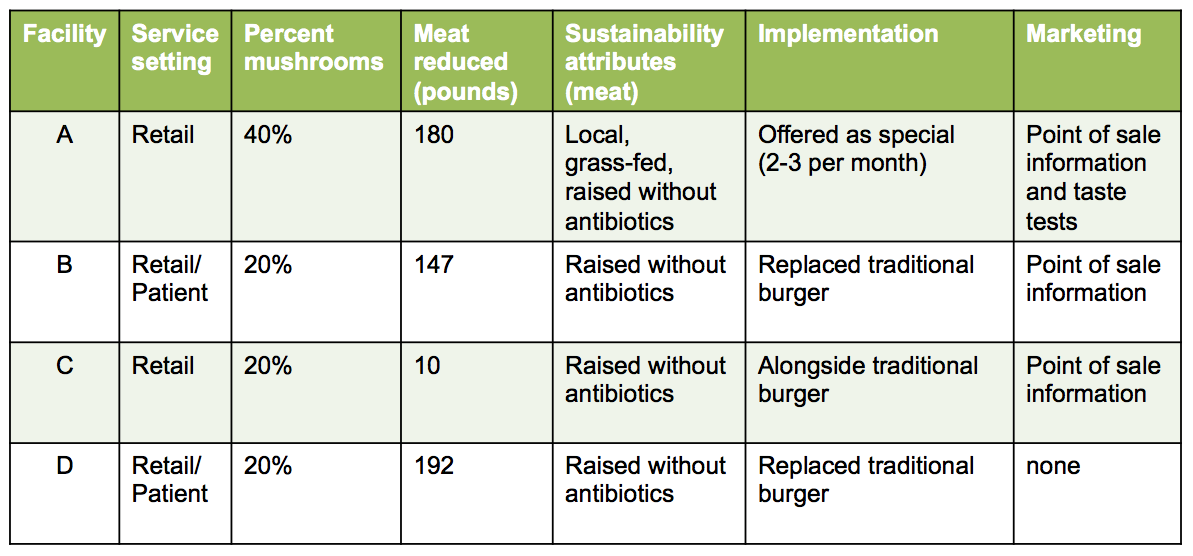Canadian Beef What Is Blended Meat
A study of iv hospitals
 Composite burger recipe creation past Beverly Hospital in Northeast Massachusetts
Composite burger recipe creation past Beverly Hospital in Northeast Massachusetts
Takeaways
- Blending mushrooms with ground meat tin reduce saturated fatty and sodium compared to an all-beef patty while maintaining the texture and flavor of traditional burgers.
- Reducing meat through blending reduces a facility'southward carbon and water footprint without taking away condolement foods.
- Blending tin can be a price neutral strategy for incorporation of "meliorate meat" such every bit local and grass-fed options raised without routine antibiotics.
- In a Massachusetts-based pilot, 4 hospitals reduced their use of meat by 529 pounds, a reduction of 24 percent, over six months.
Groundwork
"People loved the burger's flavor. Some who practise not similar mushrooms yet enjoyed it because the flavor is hidden in the beef. Many of our registered dietitians enjoyed its more nutritious qualities."
— Mary Beth Schlichtholz, Rady Children's Hospital food service managing director
Health care food service often faces competing priorities when developing menus for patients and retail outlets. They may desire to serve healthy, plant-based dishes, but also come across the demand for condolement foods. Additionally, a growing number of hospitals are working to serve sustainable meat, but are limited by balancing tight budgets. 1 solution to this dilemma is using a blending approach. A blended burger combines mushrooms (or other plant-based ingredients) with ground beefiness (or other ground meat) to reduce the total meat in the burger while improving its flavor.
Four-hospital written report
In 2017, Wellness Care Without Harm conducted a half dozen-month study on the bear upon blended burgers with a grouping of four Massachusetts hospitals. There were 3 goals for this blended burger pilot:
- Evaluate the effectiveness of blended burgers for meat reduction.
- Appraise blended burger potential for increasing access to more sustainably raised meat, without increasing costs.
- Acquire virtually the reception to the blended products from diners.
Participants in the airplane pilot could buy a blended product from their vendors or brand their own blended production in-house. The just requirement for participation was that the meat in the blended production exist raised without non-therapeutic antibiotics.

Of the iv hospitals, i purchased a blended beefiness burger comprised of 40 percent mushrooms and 60 pct local, antibiotic-gratuitous beefiness made past a local butcher. This infirmary also purchased a bulk alloy, with the same meat-to-mushroom ratio, that they used in a variety of dishes that called for ground meat.
The other three hospitals purchased a blended burger that was 20 percent mushrooms and 80 percent antibiotic-gratis beefiness from a major food distributor.
The four hospitals implemented and marketed the blended dishes in unlike means. In the retail setting, ii hospitals replaced their all-beef burger with a blended burger, one offered it every bit a weekly special, and 1 served it aslope a traditional burger. 3 of the four hospitals promoted the blended burger with marketing initiatives such every bit bespeak-of-sale signage and one offered taste tests.
"We did a sampling of the beefiness/mushroomburger at the monthly Cooking Up Health booth. We asked, 'Would you lot buy thisburger here?' We got overwhelmingly favorable results. People tin't wait to have them available on a daily basis — and that's our plan."
— Deborah P. Keane, Dartmouth-Hitchcock Medical Middle food and diet services director
Results
Meat reduction
The composite burger pilot was successful in reducing the amount of meat served at participating
institutions. Over the half-dozen-month menstruation, the four hospitals reduced their use of meat past 529 pounds, a reduction of 24 percent.
All the hospitals showed a meat reduction in accord with the meat to mushroom ratio of the product they chose.
Therefore, the amount of meat used in burgers was reduced by 40 percentage at hospital A and xx percent in hospitals B, C, and D.
The hospitals varied in a number of factors, including size and number of times the blended burger was served. This led to significant differences in the meat reduction, in pounds, at each facility.
For example hospital C reduced meat past simply 10 pounds because they sold simply 50 blended burgers, whereas hospital D was able to reduce their meat past 192 pounds because as a larger facility they served four,080 blended burgers.
While broad conclusions cannot be made from a small sample of hospitals with many uncontrolled variables, the results suggest that replacing a conventional burger with a blended burger yields a higher meat reduction than serving the blended and traditional burger side-by-side.

"Yous can lessen the meat provided and yet non experience like you are lessening the amount of meat you are eating."
— Gary Weiss, Cooley Dickinson Health Care executive chef
Sustainable meat
All hospital participants were able to source pre-made patties with beef raised without antibiotics, suggesting that a blended product could, in fact, assist health intendance institutions manage the cost of sustainably raised meat, which is often more than expensive.
Hospital A reported their blended burger was $2.05 per pound less than an all-beef, local
antibiotic-free patty, and $0.05 less than an all-beef conventional burger. Infirmary D reported the
blended burger was $0.04 cheaper per patty than the conventional all-beef patty. However, the
composite burger patty was smaller than the conventional patty, three.75 ounces compared to 5.33 ounces respectively.
While this does make the composite burger more than expensive on a per pound basis, on a per patty basis information technology reduces costs and brings it in line with federal dietary recommendations for meat consumption.
Customer satisfaction
Participants reported a positive to neutral reception from their customers almost the composite
burgers, indicating this approach may exist a valid strategy for reducing meat with diners that don't place or commonly choose vegetarian or vegan options. Finally, three of the four hospitals indicated the nutritional profile of the blended burger allowed information technology to be served to patients on restricted diets that could non have otherwise called an all-beefiness patty.
Conclusion
"One of our goals with the UH Health System is to reduce our beef purchases. We have consistently lowered our beefiness purchases year over year. We felt that adding a blended burger to the menu was a way to satiate the customer'south appetite for beef, merely to incorporate a unique way to lower the amount of beef in the burger. It likewise had bang-up flavor."
— Anthony P. Verona, University Health System culinary managing director
Serving blended burgers is a viable meat reduction strategy for health care institutions. Use of mushroom-beef blends can reduce the total amount of meat served in a hospital, without asking customers to completely give up comfort foods. Doing then too improves the nutritional profile of burger selections and contributes to environmental stewardship goals.
This pilot has demonstrated the blending arroyo is acceptable to customers every bit an alternative to all-beef burgers and that blending can be a cost-effective mode to supplant conventional meat with products that are sustainably raised.
In implementing a blended meat strategy, wellness care should evaluate products with attending to the mushroom-to-meat ratio that optimizes meat reduction, nutrition, and gustatory modality, and experiment with menuing and marketing strategies such as replacing a conventional burger with a blended burger versus serving the two burgers side-by-side. While this study focused on blending for burgers, health care should also consider blending for any ground meat dish to attain a greater impact.
Acquire more about blended burgers
Source: https://saludsindanio.org/node/5494

Enregistrer un commentaire for "Canadian Beef What Is Blended Meat"